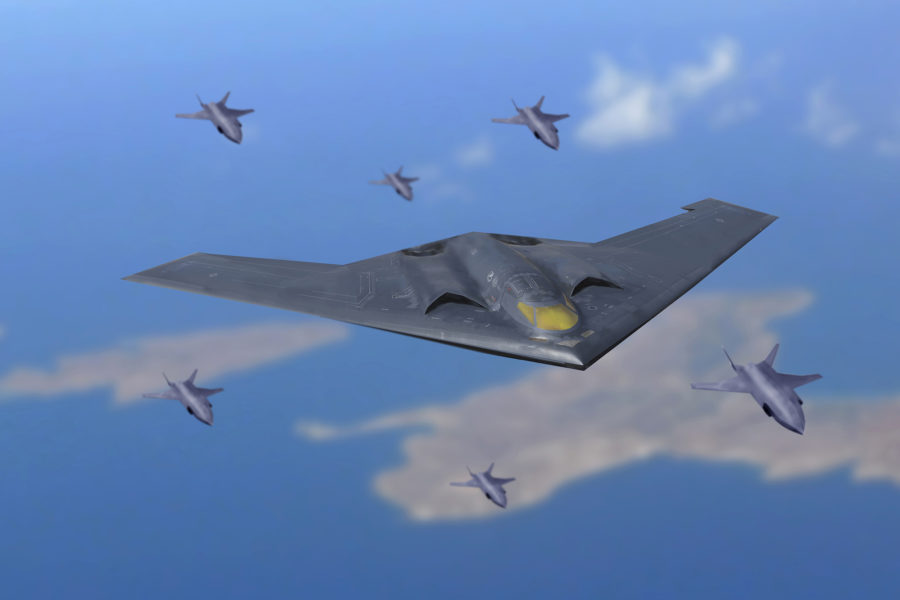Air Force Secretary Frank Kendall has backed off the idea of an unmanned bomber to pair with the B-21 Raider—but there could still be value in building low-cost, less sophisticated drones to accompany the B-21.
That was the key takeaway from a recent three-day workshop conducted by the Mitchell Institute for Aerospace Studies that gathered Air Force leaders, planners, and operators, along with industry partners, to study potential uses for what the Air Force is now calling “collaborative combat aircraft.”
In particular, the workshop focused on the long-range penetrating strike mission of the B-21—another session will be devoted to Next Generation Air Dominance later this year—and tasked three teams with designing unmanned aircraft to aid the bomber in strikes against an air base, a maritime threat, and a transporter erector launcher in a hypothetical conflict with China in 2030.
Adding an unmanned escort for the B-21 was one of seven operational imperatives Kendall introduced in late 2021, but this past July, he seemed to abandon the concept, telling Breaking Defense “the idea of a similar-range collaborative combat aircraft is not turning out to be cost-effective.”
But parsing out Kendall’s comments, there are still potential uses for shorter-range unmanned aircraft to work with the B-21, argued retired Col. Mark Gunzinger, the Mitchell Institute’s director of future concepts and capability assessments and one of the workshop leaders.
“Secretary Kendall did not impeach the idea of a long-range strike family of systems. The B-21 was designed from its outset as part of a family of systems that include unmanned systems, possibly some manned … weapons and sensors and so forth,” Gunzinger said. “So it really does need the rest of that family of systems to achieve the kind of long-range strike effects we need in highly contested threat environments.”
Indeed, while none of the teams in the workshop was prohibited from proposing a long-range escort, none did, said Caitlin Lee, senior fellow for the Mitchell Institute’s Center for Unmanned and Autonomous Systems and another workshop leader.
“Holding costs aside, the teams still preferred to build large numbers of UAVs with disaggregated capabilities,” Lee said. “And that was because they wanted mass, and there were a few different reasons for that.”
One of the key reasons was cost imposition—forcing an adversary to expend more rounds to take down separate platforms.
“If you can cause an enemy to run out of his best weapons, that increases your survivability, your effectiveness, attacking targets and doing other things significantly,” noted Gunzinger.
Other factors included increased complexity for adversaries and increased options for commanders, Lee and Gunzinger said.
Without the advantages of those large numbers of collaborative combat aircraft, or CCAs, several teams said they didn’t think a mission commander would order their mission to go forward because of the risk involved. Even when the workshop leaders imposed cost restrictions, two of the teams were willing to sacrifice capabilities on their unmanned aircraft to buy larger numbers, Lee said.
And while Kendall has described a vision of five or so CCAs to pair with a fighter like NGAD, the workshop teams envisioned numbers in the “10s or 20s,” Lee said, depending on the functions of the drones.
Functions such as counter-air and intelligence, surveillance, and reconnaissance were particularly important for teams.
“ISR is a huge gap in a China fight, and it appears that UAVs may be able to at least partially close that gap,” Lee said. “Another [takeaway] was counter-air UAVs may be able to at least partially close that gap. And another one was that, particularly for penetrating strike missions over the mainland of China, fifth-generation fighters probably don’t have the range required to support those penetrating strike missions. And UAVs may be an option to provide that escort.”
But rather than trying to have that escort fly with the B-21 for the entire mission, workshop participants chose to have their drones be “untethered” from the bomber, taking off from closer in and capable of linking up with—and peeling off from—the manned platform.
“I think we need to open our minds a little bit to think about how the CCAs can be optimized to support the mission, but not necessarily mirror image what the manned aircraft is doing,” Lee said.
In order for such a concept to work, though, the CCAs will likely have to have a level of autonomy—and that was one of the workshop’s most crucial takeaways, Lee said.
“Autonomy is really the long pole in the tent,” Lee said. “Specifically, if you wanted mass, then that mass is just a random herd of cats if it’s not all coordinated and optimized toward a single mission.”
Because of that, workshop participants largely agreed that investing in autonomy and artificial intelligence should take priority, a finding Lee said was “fascinating” given that it came from “a group of engineers who are all about designing airplanes.”
“They stepped back from this, and operators who want new capabilities to build quickly, they all sort of stepped back and said, ‘As much as we want these CCAs on the flight line tomorrow, they won’t be much good if we don’t know how we’re going to control them and optimize them to achieve the specific mission we want them to do,’” Lee said.
Beyond the specific takeaways for long-range strike, Gunzinger said the workshop also demonstrated vital collaboration as the Air Force considers how it wants to proceed with unmanned systems.
“Something I was thrilled to see … is how thrilled our players were,” Gunzinger said. “The operators who came from across the different Air Force communities, including AFRL, with industry, different industry [partners], they all worked together, and they were just pleased as hell that ‘Hey, we never do this. We got war fighters and the planners and the guys who make these aircraft together, thinking about different attributes, doing tradeoffs and costing and so forth.’ There was real value in doing that.”
